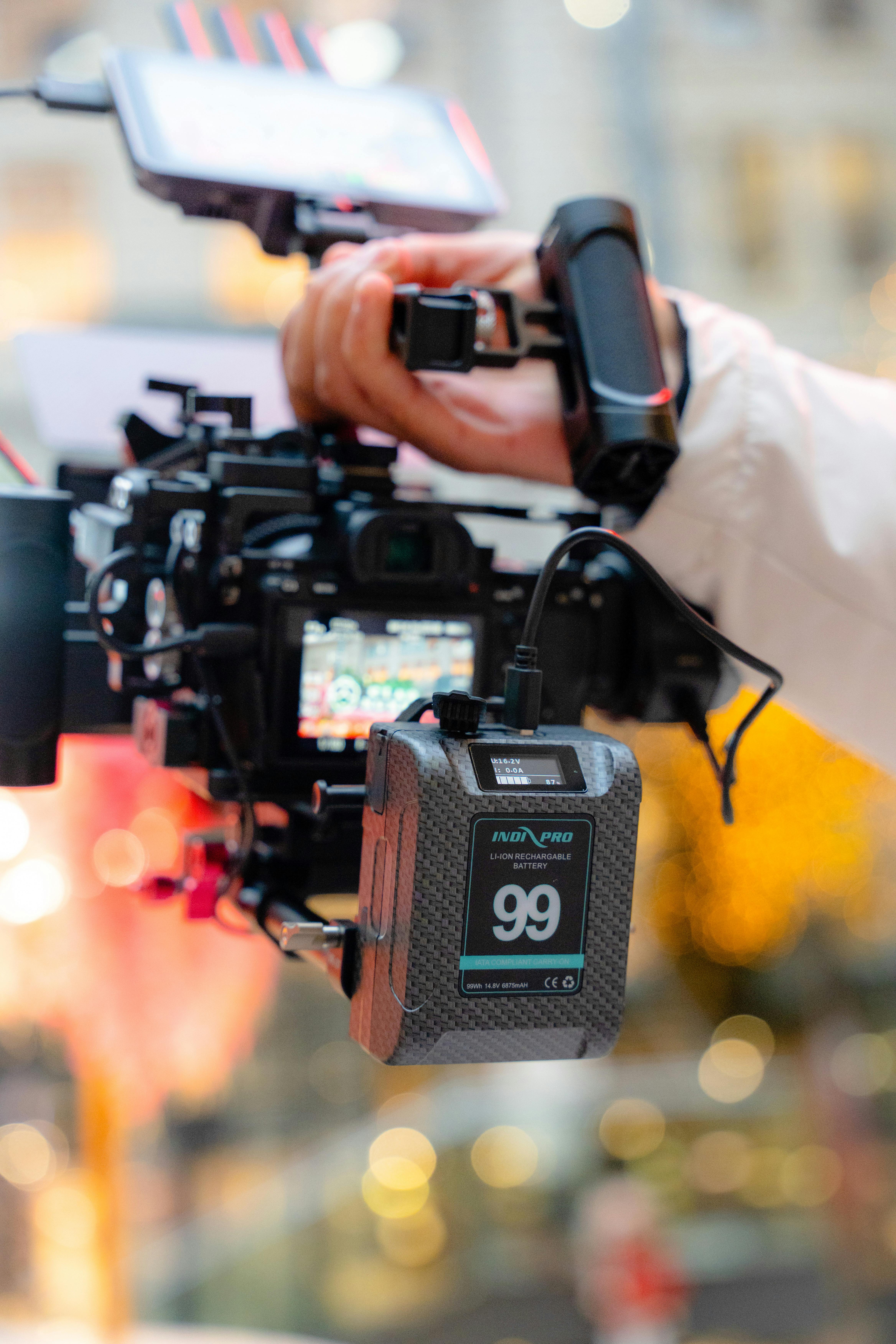If you’re diving into the world of podcasting or planning to conduct podcast interviews, you must be wondering about the three commonly used connections for microphones. Well, you’re in the right place! Today, we’ll explore the different types of connections that are frequently used when it comes to microphones. Whether you’re a seasoned podcaster or just starting out, understanding these connections will help you choose the right microphone for your needs and ensure crystal clear audio quality. So, let’s get started and unravel the mysteries of microphone connections!

Understanding The Importance of Microphone Connections
The linkage between microphone quality and connection type
When it comes to achieving high-quality audio recordings, it’s crucial to understand the importance of microphone connections. The connection type can have a significant impact on the overall sound quality and performance of a microphone. Different microphones require different connections, and choosing the right one for your specific needs is vital to ensure optimal sound reproduction.
Why different microphones have different connections
Microphones come in various shapes and sizes and are designed for different applications. The reason behind the different connections lies in the requirements of each type of microphone. XLR connectors, USB microphones, and 3.5mm jacks are the three commonly used microphone connections. Each connection has its own advantages and limitations, making it suitable for specific recording scenarios.
First Common Connection: XLR Connectors
The Composition Structure of XLR connectors
XLR connectors are widely used in professional audio setups due to their superior build quality and reliability. These connectors consist of three pins within a housing, with each pin having its own designated purpose. Pin 1 is responsible for grounding, pin 2 handles the positive audio signal, and pin 3 carries the negative audio signal. This balanced configuration ensures the highest audio quality with minimal interference or noise.
Advantages of Using XLR Connectors
One of the main advantages of using XLR connectors is their ability to provide a balanced connection. This balanced configuration minimizes electrical interference, resulting in clean and clear audio recordings. XLR connectors are also known for their durability, making them ideal for professional use where reliability is essential. Additionally, XLR connectors can carry phantom power, allowing them to power certain types of microphones.
Typical Usage Scenarios for XLR Connectors
XLR connectors are commonly found in recording studios, live sound setups, and professional audio environments. They are widely used with high-end microphones, mixing consoles, and audio interfaces. XLR connectors are also favored in situations where long cable runs are required, as they provide better signal integrity over longer distances.
XLR Connectors And The Podcasting World
Preference of XLR connectors for podcast interviews
When it comes to podcast interviews, many professionals prefer using XLR connectors. This choice is primarily driven by the need for high-quality audio and the added benefits of a balanced connection. XLR connectors ensure that the sound captured during interviews remains pristine and free from unnecessary noise or interference.
How XLRs Enhance podcasting sound quality
Using XLR connectors in podcasting can significantly enhance the overall sound quality of your recordings. The balanced connection provided by XLR connectors minimizes electrical noise and interference, resulting in a cleaner and more professional-sounding podcast. This is particularly important when multiple microphones are used simultaneously, as it helps maintain audio clarity and separation.
Equipment required for podcasting with XLR connectors
To utilize XLR connectors for podcasting, you will need a few essential pieces of equipment. Firstly, you will need a quality microphone that uses XLR connections. Additionally, you will require an audio interface or mixer that supports XLR inputs and provides the necessary preamps to amplify the microphone signal. Finally, appropriate cables and accessories, such as shock mounts and pop filters, are needed to complete your podcasting setup.
An In-depth Look At How XLR Connectors Work
The importance of the three pins in an XLR connector
Understanding the role of each pin in an XLR connector is crucial to grasp how they work. Pin 1 serves as the ground connection to eliminate unwanted electrical noise. Pin 2 carries the positive phase of the audio signal, while pin 3 carries the negative phase. This balanced configuration allows for effective noise cancellation and excellent audio signal quality.
Understanding the concept of Audio balance in XLR connectors
The concept of audio balance in XLR connectors is related to the balanced configuration of the connection. By having both a positive and negative phase in the audio signal, any interference or noise that affects the signal equally on both phases can be canceled out. This results in a much cleaner and noise-free audio signal, which is especially important in professional audio applications.
Effect of XLR connectors on Signal-to-noise ratio
XLR connectors play a significant role in improving the signal-to-noise ratio in audio recordings. The balanced nature of the XLR connection, combined with its ability to reject electrical noise, results in a higher signal-to-noise ratio. This means that the desired audio signal is more prominent and stands out above any background noise, ensuring a cleaner and more professional sound.

Second Common Connection: USB Microphones
Description and components of USB microphones
USB microphones have gained popularity due to their ease of use and plug-and-play functionality. Unlike XLR connectors, USB microphones are self-contained devices with a built-in analog-to-digital converter. These microphones connect directly to a computer or recording device via a USB cable, eliminating the need for an external audio interface or additional equipment.
Benefits of Using USB microphones
The main advantage of USB microphones lies in their simplicity and convenience. They are incredibly user-friendly, requiring no technical expertise or additional equipment to set up. USB microphones are perfect for beginners, content creators, and podcasters who don’t require the utmost professional audio quality but still want a reliable and decent sound.
Common situations for using USB microphones
USB microphones are commonly used in home recording studios, podcasting setups, and for online streaming purposes. They are an excellent choice for anyone starting their podcasting journey or those who need a portable and straightforward solution for recording audio. USB microphones are also popular among gamers and online content creators who need a quick and hassle-free way to capture their voice.
Understanding USB Microphones in Relation to Podcasting
Ease of podcast setup with USB microphones
USB microphones offer tremendous convenience when it comes to podcast setup. Since they don’t require an external audio interface or complicated setup process, getting started with podcasting becomes a breeze. Simply connect the USB microphone to your computer, choose it as the audio input device in your recording software, and you’re ready to start recording your podcast.
Factors limiting the use of USB Microphones for professional podcasting
While USB microphones are convenient, there are certain limitations that make them less suitable for professional podcasting. One of the main limitations is the lack of flexibility and upgradeability. USB microphones have built-in preamps and converters, which may not offer the same level of control and quality as separate audio interface setups. Additionally, USB microphones may not provide as much headroom for adjusting levels or using external processors.
Methods of improving podcast quality when using USB microphones
If you decide to use a USB microphone for your podcast, there are still ways to improve the overall sound quality. Consider using external pop filters or shock mounts to minimize unwanted noise and vibrations. Additionally, investing in good soundproofing, such as acoustic panels or sound blankets, can significantly enhance the audio quality. Lastly, paying attention to your recording environment and microphone placement can make a noticeable difference in the final result.

In-depth Review of The USB Microphone Connection Process
How USB microphones convert analog to digital signals
USB microphones utilize a built-in analog-to-digital converter (ADC) to convert the audio signal from analog to digital. The ADC processes the audio waveform, quantizing it into binary code that can be read and understood by the computer or recording device. The digital signal is then transmitted via the USB connection, allowing for real-time monitoring and recording.
Understanding the impact of bit rates and sampling rates on USB microphones
Bit rate and sampling rate are essential parameters that dictate the quality and fidelity of the audio recorded with USB microphones. Bit rate refers to the number of bits used to represent each sample of audio data, while the sampling rate determines how many samples per second are taken from the audio waveform. Higher bit rates and sampling rates result in higher audio quality, allowing for more accurate representation of the original sound.
Concerning microphone latency in USB connections
Latency, or the delay between the input of a sound and its playback or recording, can be a concern when using USB microphones. USB connections introduce a certain amount of latency due to the analog-to-digital conversion process and the data transmission speed. However, modern USB microphones and recording software have made significant advancements in reducing latency, making it less of an issue for most podcasting applications.
Third Common Connection: 3.5mm Jack
Structural depiction of a 3.5mm Jack
The 3.5mm jack, also known as the headphone jack, is a common connection found in consumer-grade audio devices and mobile devices. It consists of a cylindrical metal plug with a black plastic insulator, along with three metal contact points. This connection type is widely recognized for its versatility and compatibility with various devices.
Advantages of Using a 3.5mm Jack
Using a 3.5mm jack offers several advantages, primarily in terms of compatibility and ease of use. Most consumer-grade devices, such as smartphones, laptops, and portable audio recorders, feature a 3.5mm jack, allowing for effortless connectivity with microphones that use the same connection type. This makes it a practical choice for on-the-go recording or when compatibility with multiple devices is required.
Appropriate situations for a 3.5mm Jack Use
The 3.5mm jack is commonly used in casual audio recording scenarios, such as vlogging, voice memos, and basic podcasting setups. It is an excellent choice for those who need to record audio on their mobile devices or quickly connect a microphone to a laptop for simple voice recordings. The 3.5mm jack’s ubiquity and easy accessibility make it a popular choice for casual and non-professional audio recording needs.

Implementing 3.5mm Jack in Podcasting
Why many podcast starters use 3.5mm Jack
For those starting their podcasting journey on a budget or with limited technical knowledge, the 3.5mm jack can be an attractive choice. Many beginners opt for microphones with a 3.5mm jack connection due to their affordability and ease of use. This allows them to get started with podcasting without investing in additional equipment or complicated setups.
How 3.5mm Jack may affect your podcast’s sound quality
While using a 3.5mm jack is convenient, it’s important to be aware of its potential impact on sound quality. The 3.5mm jack connection is more susceptible to electrical interference and background noise compared to balanced connections like XLR. This can result in lower audio quality and potentially compromise the overall professional sound of your podcast.
Understanding the limitations of using 3.5mm Jack for podcasting
There are certain limitations to consider when using a 3.5mm jack for podcasting. Firstly, the 3.5mm connection is generally not suitable for longer cable runs, as the audio signal can degrade over distance. Additionally, the lack of balanced configuration in 3.5mm jack connections means that the microphone may be more susceptible to external interference and noise. For professional podcasting, it is often recommended to upgrade to a more robust and reliable connection type.
Diving Into The Technical Basics of a 3.5mm Jack
The conversion process in a 3.5mm Jack scenario
The 3.5mm jack connection is an analog connection that directly carries the audio signal from the microphone to the recording device without any digital conversion. The audio signal is transmitted through the metal contact points of the jack, allowing it to be captured by the input device, such as a smartphone or laptop. This simplicity makes it a straightforward and plug-and-play solution for basic audio recording needs.
How Stereo and Mono configurations influence 3.5mm Jack operations
The 3.5mm jack can support both stereo and mono configurations, depending on the microphone and device setup. Stereo configurations utilize two audio channels, allowing for a more immersive audio experience. Mono configurations utilize a single audio channel and are suitable for basic voice recording or podcasting. The choice between stereo and mono depends on the specific requirements of the recording and playback setup.
Dealing with Microphone sensitivity in 3.5mm Jack connections
Microphone sensitivity refers to the level of audio input required to produce a certain output level. When using a 3.5mm jack connection, it’s important to consider the microphone sensitivity and adjust the input levels accordingly. Some microphones may require additional amplification or audio adjustments to achieve optimal recording levels. This can be done through the recording software or with the help of external audio processors if needed.
In conclusion, understanding the importance of microphone connections is vital for achieving high-quality audio recordings. XLR connectors offer balanced connections, durability, and excellent audio quality, making them the preferred choice in professional environments. USB microphones provide convenience and simplicity, making them popular among beginners and casual users. 3.5mm jack connections offer compatibility and ease of use but may have limitations in terms of audio quality and interference. Selecting the right microphone connection type for your specific needs and utilizing the appropriate equipment will ensure optimal sound reproduction and enhance your podcasting experience.

